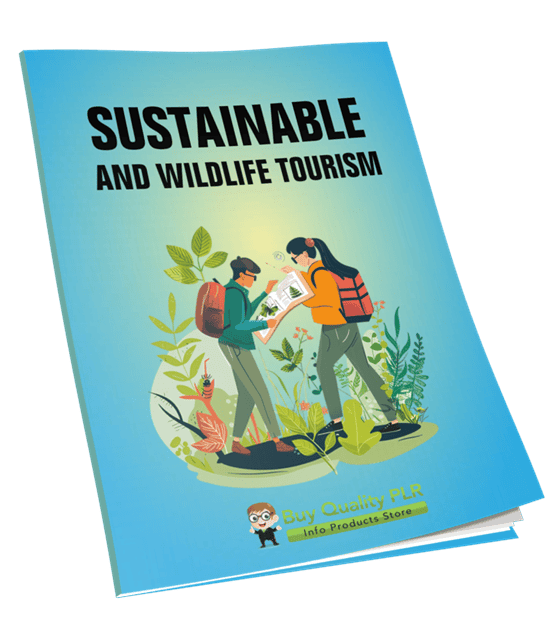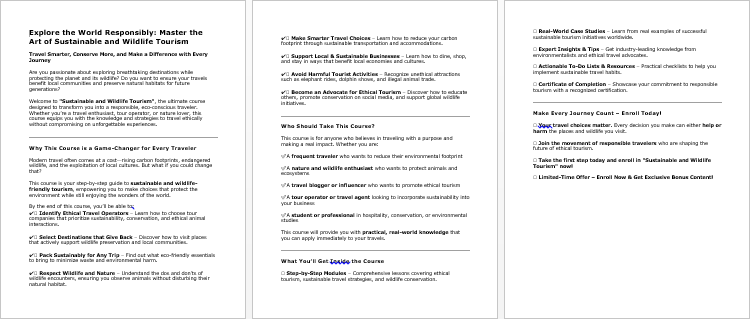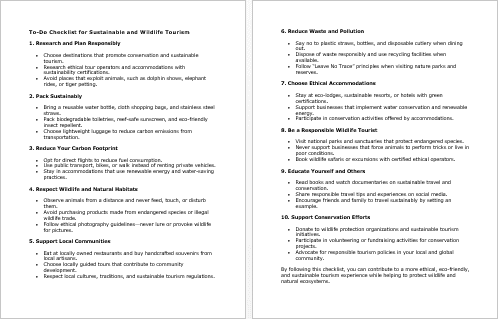
Sustainable and Wildlife Tourism 20k Words
in PLR Checklists , PLR eBooks , PLR eCourses , PLR List Building Reports , Premium PLR , Premium PLR eBooks , Premium PLR Reports , Premium White Label Brandable PLR Coaching Courses , Private Label Rights Products , Travel PLR , Travel PLR eBooksChoose Your Desired Option(s)
has been added to your cart!
have been added to your cart!
#sustainabletourism #wildlifetravel #ecotourism #greentravel #plrcontent #travelmarketing #responsibletravel #plrcourse
Sustainable and Wildlife Tourism PLR Course – Travel Responsibly and Make a Positive Impact
A Step-by-Step Training Course for Ethical and Responsible Travel
Discover how to explore the natural world responsibly with our Sustainable and Wildlife Tourism PLR Course. Designed for travelers, tour guides, and tourism professionals, this course teaches the principles of ethical tourism, conservation, and environmental responsibility. Whether you’re running a travel business, creating online courses, or producing educational content, this PLR course gives you ready-to-use materials to educate, inspire, and profit—all while promoting sustainable travel practices.
Why Sustainable and Wildlife Tourism Matters
Tourism has the power to generate income, create jobs, and foster cultural exchange—but it can also harm ecosystems, displace wildlife, and negatively impact local communities. Sustainable and ethical tourism practices help:
- Protect fragile ecosystems and endangered wildlife
- Support local communities economically and socially
- Reduce environmental impact through conscious choices
- Encourage conservation and responsible engagement with nature
- Educate travelers to make positive, long-term decisions
With this PLR course, your audience will learn how to travel with purpose, minimizing harm while maximizing benefits for both the planet and its people.
Presenting…
Sustainable and Wildlife Tourism 20k Words
Course Overview
Sustainable and Wildlife Tourism PLR Course is 18,761 words of premium content, structured into 5 comprehensive modules, each with 4 actionable steps. This course is perfect for creating:
- Digital courses
- Membership site content
- Guides and eBooks
- Blog posts or newsletters
- Lead magnets or online workshops
Here’s a detailed breakdown of what your audience will learn:
Module 1: Understanding Sustainable & Wildlife Tourism
Objective: Learn the foundations of sustainable travel and why ethical wildlife tourism is crucial.
- Step 1: What is Sustainable Tourism?
Discover how sustainable tourism balances economic, social, and environmental factors for long-term benefits. - Step 2: Why Wildlife Tourism Needs to Be Ethical
Understand the consequences of unethical tourism on animals and habitats, and why responsible wildlife tourism is essential for conservation. - Step 3: The Triple Bottom Line of Tourism
Learn about the three pillars of sustainability—People, Planet, and Profit—and how to integrate them into tourism planning. - Step 4: The Role of Tourists in Conservation
Practical tips for travelers to minimize impact, support local economies, and preserve wildlife while enjoying meaningful experiences.
This module ensures learners understand why their choices matter and sets the stage for responsible travel.
Module 2: Planning a Responsible Wildlife Adventure
Objective: Equip travelers with tools to plan eco-friendly and ethical wildlife experiences.
- Step 1: Choosing Ethical Tour Operators
Learn how to identify eco-certified companies that prioritize conservation and ethical animal interactions. - Step 2: Picking the Right Destinations
Find wildlife destinations that avoid overtourism, support conservation, and benefit local communities. - Step 3: Sustainable Packing Essentials
Pack light, eco-friendly, and responsible: reusable bottles, biodegradable toiletries, and minimal waste gear. - Step 4: Understanding Local Cultures & Guidelines
Respect cultural traditions, wildlife protection laws, and local conservation initiatives to ensure a meaningful and responsible visit.
This module empowers travelers to plan trips that are safe for both wildlife and local communities.
Module 3: Responsible Wildlife Encounters
Objective: Teach practical ways to observe wildlife ethically and safely.
- Step 1: Observing Animals Without Disturbing Them
Follow key wildlife-watching rules: maintain distance, avoid loud noises, and skip flash photography. - Step 2: Avoiding Harmful Tourist Activities
Recognize and refuse activities like elephant rides or marine shows that exploit animals. - Step 3: Supporting Ethical Animal Sanctuaries & Rescues
Identify true sanctuaries that rehabilitate animals versus commercial operations that prioritize profit. - Step 4: Respecting Marine Life & Underwater Tourism
Responsible snorkeling and diving practices, including avoiding touching coral reefs and marine animals, to protect fragile ecosystems.
Learners will gain practical skills to interact with wildlife safely while leaving minimal ecological footprint.
Module 4: Reducing Your Environmental Impact While Traveling
Objective: Equip travelers with strategies to minimize waste, carbon footprint, and resource consumption.
- Step 1: Practicing “Leave No Trace” Principles
Seven principles of ethical outdoor behavior, including proper waste disposal and respecting wildlife and habitats. - Step 2: Eco-Friendly Transportation Choices
Tips for sustainable travel: trains, cycling, electric vehicles, and carbon-offset programs for flights. - Step 3: Supporting Local & Sustainable Businesses
Stay in eco-certified accommodations, dine locally, and buy from sustainable shops to strengthen local economies. - Step 4: Reducing Plastic Waste & Single-Use Items
Use reusable bags, water bottles, and eco-friendly products to cut down on pollution.
This module teaches how every small action contributes to a healthier planet.
Module 5: Promoting and Advocating for Sustainable Tourism
Objective: Become an ambassador for sustainable and ethical travel practices.
- Step 1: Educating Fellow Travelers
Learn how to inspire others by sharing sustainable travel knowledge and encouraging responsible behavior. - Step 2: Using Social Media Responsibly
Post photos and stories that respect wildlife and promote ethical tourism practices, avoiding exploitation. - Step 3: Supporting Conservation Organizations
Ways to contribute to wildlife protection through donations, volunteering, or fundraising. - Step 4: Continuing Your Sustainable Travel Journey
Resources for ongoing learning: books, documentaries, courses, and eco-tourism communities.
By the end of this module, learners are empowered to share knowledge, influence others, and maintain sustainable habits long-term.
Additional Materials Included
- Sustainable and Wildlife Tourism – Checklist (381 words): Quick reference for travelers to follow ethical practices every time.
- Sustainable and Wildlife Tourism – FAQs (1,062 words): Clear guidance for common questions and challenges in eco-friendly tourism.
- Sustainable and Wildlife Tourism – Salespage (573 words): Ready-to-use marketing material to sell the course immediately.
These resources save time and ensure you can launch your PLR product instantly.
How You Can Use and Profit from This PLR Course
Sustainable and Wildlife Tourism PLR Course opens multiple revenue opportunities for entrepreneurs and content creators:
- Sell as a Complete Digital Course
Launch on platforms like Kajabi, Teachable, or Thinkific, targeting eco-conscious travelers or tourism students. - Break Into Mini-Guides or Reports
Use individual modules as standalone reports or guides ($10–$20 each). - Bundle for High-Value Packages
Combine with other travel or eco-lifestyle PLR products to create premium bundles ($47–$97). - Membership Sites & Subscription Services
Offer ongoing eco-tourism content as part of a monthly membership program. - Create Multimedia Content
Convert text into videos, audio guides, slides, or interactive PDFs to sell or distribute digitally. - Lead Magnets & Email Marketing
Use modules as free or paid lead magnets to grow your email list or promote other products. - Flip for Profit
Brand and customize the content, create a niche website, and sell it as a complete digital business package.
This PLR product is flexible, allowing you to monetize through multiple streams quickly.
Why Choose This PLR Course
- Comprehensive, Ready-to-Use Content: 18,761 words of professionally written material.
- Editable and Brandable: Tailor content to your brand, audience, or niche.
- Evergreen Niche: Sustainable and ethical tourism is growing in popularity worldwide.
- Multiple Uses: Perfect for online courses, memberships, eBooks, or workshops.
- Immediate Launch: Modules, checklist, FAQs, and sales page included—go live instantly.
License Terms
Permissions:
- Sell, rebrand, and edit the course.
- Use as standalone or bundled content.
- Convert to audio, video, or membership site material.
- Use portions for blog posts, newsletters, or lead magnets.
Restrictions:
- Cannot transfer PLR rights to customers.
- Cannot give away the full course in original form for free.
- Maximum affiliate commission: 75% if used for affiliate marketing.
Take Action Today!
With the Sustainable and Wildlife Tourism PLR Course, you can:
- Teach travelers to explore responsibly
- Create a profitable digital product in the growing eco-tourism niche
- Save weeks of content creation with a ready-to-go package
Next Steps:
- Download the PLR package immediately.
- Customize and brand the course for your target audience.
- Launch your product digitally or as part of a membership or bundle.
Your audience wants to travel ethically, support conservation, and reduce environmental impact. Provide them with the tools they need and profit from a high-demand, evergreen topic.
has been added to your cart!
have been added to your cart!
Here A Sample of Sustainable and Wildlife Tourism PLR Course
This course is designed for travelers, tour guides, and tourism professionals who want to explore the beauty of nature and wildlife while ensuring ethical, responsible, and sustainable tourism practices. By the end of this course, you’ll have the knowledge and tools to minimize your environmental impact, support local communities, and promote conservation efforts.
Module 1: Understanding Sustainable & Wildlife Tourism
Objective: Learn the basics of sustainable tourism and why it’s crucial for preserving natural habitats and wildlife.
Step 1: What is Sustainable Tourism?
Sustainable tourism is a responsible approach to travel that balances three key factors: economic growth, social well-being, and environmental conservation. The goal is to ensure that tourism benefits both current and future generations without harming local cultures, ecosystems, or economies.
To understand sustainable tourism fully, let’s break it down into three essential components:
1. Economic Sustainability: Creating Long-Term Financial Benefits
Tourism is a major economic driver in many countries, providing jobs, supporting businesses, and generating revenue for local and national economies. However, when tourism is not managed responsibly, it can lead to financial instability, economic inequality, and exploitation.
How economic sustainability in tourism works:
- Supporting local businesses, artisans, and entrepreneurs instead of large multinational corporations ensures that money stays within the community.
- Encouraging fair wages, ethical labor practices, and equal opportunities in the tourism industry helps reduce poverty and economic disparity.
- Implementing sustainable tourism policies, such as visitor caps or entrance fees to protected areas, ensures long-term revenue generation for conservation efforts.
- Diversifying tourism offerings (e.g., cultural tourism, eco-tourism, and rural tourism) reduces overdependence on a single type of tourism and creates resilience against market fluctuations.
Economic sustainability means that tourism should not only generate income but also distribute it fairly and protect long-term economic health without overexploiting resources.
2. Social Sustainability: Protecting Local Cultures and Communities
Tourism has the power to connect people, promote cultural exchange, and strengthen community pride. However, it can also lead to cultural erosion, displacement of local populations, and loss of traditions if not carefully managed.
Key principles of social sustainability in tourism:
- Respecting and preserving indigenous cultures, traditions, and languages ensures that tourism does not dilute or harm cultural heritage.
- Promoting community-led tourism initiatives allows local people to have control over their tourism industry rather than being sidelined by large corporations.
- Encouraging meaningful interactions between tourists and local residents fosters understanding, respect, and authentic experiences.
- Ensuring that tourism does not lead to overcrowding or displacement of local populations by implementing sustainable urban and rural planning strategies.
Social sustainability ensures that tourism brings positive social impacts by protecting local identities and promoting ethical engagement between visitors and host communities.
3. Environmental Sustainability: Protecting Nature and Wildlife
One of the biggest concerns in global tourism is its environmental impact. Mass tourism can lead to deforestation, pollution, excessive waste, carbon emissions, and damage to fragile ecosystems. Sustainable tourism aims to reduce the environmental footprint of travelers while promoting conservation.
How environmental sustainability in tourism works:
- Eco-friendly travel choices: Using low-carbon transportation options such as trains, cycling, and electric vehicles reduces pollution and greenhouse gas emissions.
- Wildlife protection: Supporting ethical wildlife tourism that avoids animal exploitation and helps protect endangered species and their habitats.
- Waste reduction: Using reusable water bottles, avoiding single-use plastics, and properly disposing of waste minimizes pollution.
- Conserving resources: Encouraging responsible water and energy consumption in hotels, resorts, and tourist attractions.
- Preserving natural landscapes: Implementing strict regulations on construction, logging, and mining in ecologically sensitive areas to prevent destruction.
Environmental sustainability ensures that tourism does not harm biodiversity, ecosystems, or wildlife, allowing future generations to experience nature’s beauty.
The Balance Between Economic, Social, and Environmental Sustainability
Sustainable tourism is successful only when all three components—economic, social, and environmental—are balanced. If one aspect is prioritized over the others, tourism can become unsustainable and harmful in the long run.
For example:
- If economic growth is prioritized but environmental concerns are ignored, tourism can lead to pollution, deforestation, and the destruction of wildlife habitats.
- If environmental conservation is prioritized without considering local communities, people may lose jobs, and economies may struggle.
- If cultural preservation is prioritized but economic and environmental sustainability are ignored, communities may not have the financial means to protect their heritage.
Sustainable tourism creates a win-win situation where travelers, businesses, local communities, and nature can thrive together.
How Tourists Can Contribute to Sustainable Tourism
As a traveler, you have the power to support sustainable tourism by making conscious choices at every stage of your journey:
- Research ethical destinations and tour operators before booking a trip. Look for eco-certifications and sustainable tourism policies.
- Choose eco-friendly accommodations that prioritize water and energy conservation, use sustainable materials, and support local economies.
- Respect local cultures and traditions by learning about customs, dressing appropriately, and engaging with communities in a meaningful way.
- Minimize waste and reduce your carbon footprint by carrying reusable travel items, using public transportation, and supporting responsible travel initiatives.
- Support conservation efforts by visiting national parks, wildlife sanctuaries, and eco-tourism projects that promote sustainability and protect natural habitats.
Sustainable tourism is not just a trend—it’s a necessary shift to ensure that future generations can continue to explore and enjoy the world without harming it.
Step 2: Why Wildlife Tourism Needs to Be Ethical
Wildlife tourism allows travelers to experience the beauty of nature and observe animals in their natural habitats. However, not all wildlife tourism is ethical. In many cases, animals suffer behind the scenes due to poor practices, habitat destruction, and commercial exploitation.
Ethical wildlife tourism is about ensuring that tourism activities do not harm animals, disrupt ecosystems, or exploit wildlife for human entertainment. Instead, it should support conservation efforts, protect endangered species, and promote responsible interactions between people and nature.
To understand why wildlife tourism needs to be ethical, let’s explore the key problems caused by unethical practices and the principles of responsible wildlife tourism.
1. The Hidden Harm of Unethical Wildlife Tourism
Many wildlife tourism attractions appear ethical on the surface, but behind closed doors, animals may suffer from mistreatment, captivity, and unnatural behaviors. Here are some of the major issues associated with unethical wildlife tourism:
- Wildlife Exploitation for Entertainment: Animals used in shows, selfies, or interactive experiences are often taken from the wild, kept in poor conditions, and subjected to unnatural behaviors. For example, elephant rides, tiger cub petting, and dolphin shows often involve harsh training methods and deprivation.
- Destruction of Natural Habitats: Unregulated tourism can lead to deforestation, pollution, and ecosystem degradation. When too many visitors enter fragile environments, wildlife is displaced, breeding patterns are disrupted, and food sources are depleted.
- Unethical Breeding and Captivity: Many so-called “wildlife sanctuaries” are actually breeding centers that keep animals in captivity for profit. For example, some tiger parks in Asia breed tigers for tourism while selling their body parts illegally in the black market.
- Feeding and Baiting Wild Animals: Some tourism operations attract animals by feeding them, which disrupts their natural behavior, creates dependency on humans, and increases human-wildlife conflicts. For example, baiting sharks for cage diving can alter their hunting patterns and make them more aggressive toward humans.
These practices damage ecosystems, endanger species, and contribute to animal suffering. Ethical wildlife tourism seeks to reverse these effects and create positive impacts for both wildlife and local communities.
2. The Role of Ethical Wildlife Tourism in Conservation
Ethical wildlife tourism is not just about avoiding harm—it can also play a critical role in conservation efforts by funding wildlife protection programs, supporting local communities, and promoting education.
How ethical wildlife tourism contributes to conservation:
- Protecting Natural Habitats: Ethical tourism encourages responsible practices such as limiting visitor numbers, reducing waste, and supporting national parks and protected areas.
- Funding Conservation Projects: Entrance fees from ethical wildlife tourism sites are often used to fund conservation programs, anti-poaching efforts, and habitat restoration projects.
- Educating Visitors on Wildlife Protection: Ethical wildlife tourism teaches travelers about biodiversity, conservation challenges, and responsible travel behaviors, leading to increased awareness and global advocacy for wildlife protection.
- Supporting Local Communities: Ethical tourism initiatives provide jobs for local people in conservation, guiding, and eco-tourism. This reduces dependence on activities like hunting, poaching, and illegal logging.
Ethical wildlife tourism turns tourism into a tool for good, ensuring that animals and ecosystems benefit from human interaction rather than suffer from it.
3. How to Identify Ethical Wildlife Tourism
As a responsible traveler, it’s essential to know how to distinguish between ethical and unethical wildlife tourism. Here are some key ways to identify whether an attraction or tour is ethical:
- Animals Should Be in the Wild or Large Natural Enclosures: Ethical wildlife tourism does not involve animals performing tricks, being caged, or being confined to small spaces. Sanctuaries and reserves should allow animals to live as naturally as possible.
- No Physical Interaction with Wild Animals: Ethical tourism does not allow activities like petting tigers, riding elephants, swimming with dolphins in captivity, or holding wild animals for photos. Instead, responsible tourism promotes observing animals from a safe and respectful distance.
- No Forced or Unnatural Behavior: Ethical wildlife attractions do not force animals to entertain tourists. If animals are being trained to perform tricks, pose for photos, or behave unnaturally, the attraction is likely unethical.
- Conservation Over Profit: Responsible wildlife tourism prioritizes animal welfare, conservation, and education over commercial entertainment. Ethical operators use profits to fund conservation efforts rather than for-profit exploitation.
- Transparency in Operations: Ethical sanctuaries and reserves openly share information about their conservation efforts, funding, and animal welfare practices. If an organization refuses to answer questions about its practices, it may not be ethical.
By choosing ethical wildlife tourism experiences, travelers support real conservation work and help ensure a better future for wildlife.
4. Responsible Wildlife Tourism Practices for Travelers
As a traveler, you have the power to support ethical wildlife tourism by making informed and responsible choices. Here’s how you can contribute:
- Research Before You Visit: Check if a wildlife attraction is accredited by reputable conservation organizations such as the Global Sustainable Tourism Council (GSTC) or the World Wildlife Fund (WWF).
- Say No to Animal Exploitation: Avoid attractions that offer elephant rides, tiger selfies, dancing bears, or dolphin performances. Instead, choose wildlife experiences that allow for natural and respectful observation.
- Choose Certified Eco-Tours: Support tour operators that follow ethical and sustainable practices, such as small-group wildlife tours that minimize environmental impact.
- Observe, Don’t Disturb: When in nature, maintain a safe distance from animals, do not feed them, and follow the guidelines set by park rangers and conservationists.
- Support Conservation-Focused Tourism: Visit national parks, marine reserves, and ethical sanctuaries where your entrance fee helps fund wildlife protection programs.
- Raise Awareness and Advocate for Change: Educate others about ethical wildlife tourism and share information about responsible travel choices. The more people understand the impact of their travel decisions, the greater the positive change we can create for wildlife.
By following these principles, wildlife tourism can become a force for conservation rather than a cause of harm. Ethical tourism benefits not only the animals but also local communities and future generations who will be able to experience nature’s beauty without exploitation.
Step 3: The Triple Bottom Line of Tourism
Sustainable tourism is not just about preserving nature; it’s about balancing three essential pillars—People, Planet, and Profit. These three pillars make up what is known as the Triple Bottom Line (TBL), a framework that ensures tourism benefits local communities, the environment, and the economy.
The Triple Bottom Line approach helps businesses and travelers understand their impact and make decisions that contribute to long-term sustainability. By focusing on these three factors, tourism can create positive, lasting change while minimizing harm.
Let’s break down each pillar to see how it applies to the tourism industry.
1. People: The Social Responsibility of Tourism
Tourism affects the people who live, work, and depend on the destinations travelers visit. The social pillar of the Triple Bottom Line ensures that tourism:
- Supports Local Communities: Sustainable tourism provides fair wages, safe working conditions, and economic opportunities for local people. This prevents exploitation and ensures communities benefit from tourism.
- Respects Local Cultures and Traditions: Many destinations have rich cultural traditions that should be preserved, not commercialized or disrespected. Ethical tourism promotes cultural exchange and encourages visitors to appreciate local customs without appropriation.
- Promotes Inclusion and Fairness: Sustainable tourism should empower women, Indigenous groups, and marginalized communities by providing equal job opportunities and representation in decision-making.
- Encourages Meaningful Experiences: When tourism is people-centered, it creates authentic experiences that foster deeper connections between visitors and locals. This leads to greater respect, understanding, and appreciation of different cultures.
When tourism is not managed responsibly, local communities can suffer from overcrowding, loss of cultural identity, and economic exploitation. Sustainable tourism prioritizes people’s well-being, ensuring that local residents benefit rather than being displaced or marginalized.
2. Planet: The Environmental Responsibility of Tourism
Tourism has a significant impact on the environment, both positive and negative. Without responsible practices, tourism can contribute to deforestation, pollution, habitat destruction, and climate change. The Planet pillar of the Triple Bottom Line ensures that tourism:
- Minimizes Environmental Footprint: Sustainable tourism reduces carbon emissions, waste, and resource consumption by encouraging eco-friendly practices like using renewable energy, reducing single-use plastics, and conserving water.
- Protects Natural Habitats and Wildlife: Ethical tourism preserves biodiversity by respecting ecosystems, preventing deforestation, and ensuring wildlife is not harmed or exploited for entertainment.
- Encourages Responsible Travel Practices: Travelers can reduce their impact by choosing eco-friendly transportation, staying in sustainable accommodations, and supporting conservation-focused activities.
- Supports Climate Action: The tourism industry must adapt to and mitigate climate change by implementing green infrastructure, reducing air travel emissions, and investing in reforestation and conservation projects.
If tourism does not prioritize the environment, destinations can become polluted, overcrowded, and ecologically damaged. Sustainable tourism ensures that natural wonders remain protected for future generations.
3. Profit: The Economic Responsibility of Tourism
For tourism to be truly sustainable, it must also be economically viable. The Profit pillar of the Triple Bottom Line ensures that tourism generates long-term financial benefits for businesses, local economies, and conservation efforts—without harming people or the planet. This includes:
- Supporting Local Businesses: Instead of relying on large multinational corporations, sustainable tourism invests in local businesses, helping communities retain economic benefits. Travelers can contribute by shopping locally, dining at independent restaurants, and choosing locally owned accommodations.
- Creating Sustainable Jobs: Ethical tourism ensures that jobs are fair, stable, and provide living wages rather than seasonal or exploitative employment. This allows local residents to thrive, rather than just survive, in tourism-dependent areas.
- Funding Conservation and Community Projects: Tourism revenue should be reinvested into environmental conservation, cultural preservation, and social programs rather than being extracted by large corporations.
- Ensuring Long-Term Economic Stability: Unsustainable tourism can lead to over-reliance on tourism income, leaving communities vulnerable during crises (such as pandemics or natural disasters). A sustainable approach diversifies income sources, ensuring long-term economic security.
When tourism prioritizes short-term profits over sustainability, it can lead to environmental degradation, loss of cultural heritage, and economic instability. Sustainable tourism balances profitability with social and environmental responsibility, ensuring that tourism remains a force for good rather than exploitation.
Why the Triple Bottom Line Matters in Tourism
The Triple Bottom Line approach ensures that tourism is not just about making money, but also about protecting nature and improving lives. When all three pillars—People, Planet, and Profit—are balanced, tourism becomes a powerful tool for positive change.
Sustainable tourism businesses and travelers must actively consider their impact on these three areas to ensure tourism is responsible, ethical, and beneficial for everyone involved.
Step 4: The Role of Tourists in Conservation
Tourists play a critical role in conservation efforts. Every choice made while traveling—from where to stay and what to eat, to how to interact with wildlife and local communities—has an impact on the environment and local economies.
By making responsible decisions, travelers can actively contribute to protecting biodiversity, supporting local cultures, and promoting ethical tourism practices. The key to responsible tourism is awareness, respect, and informed decision-making.
Let’s explore how tourists can help protect nature, wildlife, and communities while traveling.
1. Choosing Sustainable Destinations and Accommodations
One of the most impactful decisions a traveler can make is choosing destinations and accommodations that prioritize sustainability. This includes:
- Visiting eco-friendly destinations: Some locations have strict sustainability policies, such as wildlife sanctuaries, eco-tourism reserves, and carbon-neutral cities. These destinations actively work towards conservation and ensure tourism benefits local communities.
- Staying in sustainable lodges and hotels: Eco-friendly accommodations reduce energy and water consumption, minimize waste, and support local communities. Look for certifications such as LEED, Green Key, or EarthCheck that verify a hotel’s commitment to sustainability.
- Opting for homestays or locally owned lodges: Staying with local hosts or in community-run eco-lodges ensures that money spent stays within the local economy rather than going to international corporations.
Tourists should research their destinations and accommodations in advance to ensure their choices align with conservation and sustainability principles.
2. Practicing Responsible Wildlife Tourism
Wildlife tourism can be an incredible and educational experience, but it must be approached ethically to prevent harm to animals and ecosystems. Responsible tourists should:
- Avoid attractions that exploit animals: Activities like riding elephants, taking photos with drugged tigers, or watching captive dolphin shows contribute to animal abuse and wildlife trafficking. Ethical wildlife tourism prioritizes animal welfare and does not disrupt their natural behaviors.
- Observe animals from a safe and respectful distance: Whether on a safari, in a marine reserve, or hiking through national parks, never touch, feed, or disturb wildlife. Use binoculars and zoom lenses instead of trying to get too close.
- Support conservation-friendly wildlife experiences: Visit rehabilitation centers, ethical sanctuaries, and guided eco-tours run by conservationists that genuinely work to protect species rather than exploit them for profit.
- Never buy wildlife products: Souvenirs made from ivory, coral, tortoiseshell, or animal skins contribute to illegal wildlife trade and biodiversity loss. Avoid purchasing any products that harm animals or ecosystems.
Tourists who prioritize ethical wildlife experiences help fund conservation efforts while ensuring animals are protected in their natural habitats.
3. Reducing Environmental Impact While Traveling
Tourism often contributes to carbon emissions, waste production, and habitat destruction. However, responsible travelers can minimize their environmental footprint by making conscious choices, such as:
- Using eco-friendly transportation: Choose public transport, cycling, walking, or electric vehicles over fuel-heavy options. When flying, opt for direct flights and consider carbon offset programs.
- Minimizing plastic waste: Carry a reusable water bottle, shopping bag, utensils, and containers to avoid single-use plastics, which pollute oceans and harm wildlife.
- Respecting natural landscapes: Stay on designated trails, avoid picking plants, and never leave trash behind. “Leave No Trace” principles help protect fragile ecosystems.
- Saving water and energy: Take shorter showers, turn off lights and air conditioning when leaving a room, and use towels and linens for multiple days rather than requesting daily replacements.
Small actions by travelers can collectively reduce tourism’s negative impact on the environment and help preserve destinations for future generations.
4. Supporting Local Communities and Economies
Tourism can be a powerful force for good when it directly benefits local people, businesses, and cultural heritage. Travelers can support communities by:
- Buying locally made products: Instead of purchasing mass-produced souvenirs, choose handcrafted items from local artisans. This helps preserve traditional crafts and ensures money stays within the community.
- Eating at locally owned restaurants: Dining at small, family-run establishments supports local farmers, chefs, and entrepreneurs while offering a more authentic experience.
- Hiring local guides and tour operators: Local guides provide insights into culture, history, and nature while ensuring that tourism revenue benefits residents rather than foreign-owned businesses.
- Respecting cultural traditions and etiquette: Learn about local customs, dress codes, and social norms before visiting a destination. Being culturally aware and respectful enhances positive interactions between tourists and locals.
By supporting local economies, travelers help create sustainable livelihoods while promoting cultural heritage and community development.
Why Tourists Play a Crucial Role in Conservation
Tourists are not just visitors—they are participants in the global effort to protect nature, wildlife, and cultures. Every choice made while traveling has a ripple effect, influencing conservation efforts, ethical tourism practices, and the well-being of local communities.
By traveling responsibly, tourists become ambassadors for sustainable tourism, helping ensure that destinations remain beautiful, thriving, and accessible for future generations.
We’re also giving these extra bonuses
Sustainable and Wildlife Tourism – Checklist
Sustainable and Wildlife Tourism – FAQs

Sustainable and Wildlife Tourism – Salespage Content

Package Details:
Word Count: 18 761 Words
Number of Pages: 94
Sustainable and Wildlife Tourism – Bonus Content
Checklist
Word Count: 467 words
FAQs
Word Count: 1126 words
Salespage Content
Word Count: 674 words
Total Word Count: 20 777 Words
Your PLR License Terms
PERMISSIONS: What Can You Do With These Materials?
Sell the content basically as it is (with some minor tweaks to make it “yours”).
If you are going to claim copyright to anything created with this content, then you must substantially change at 75% of the content to distinguish yourself from other licensees.
Break up the content into small portions to sell as individual reports for $10-$20 each.
Bundle the content with other existing content to create larger products for $47-$97 each.
Setup your own membership site with the content and generate monthly residual payments!
Take the content and convert it into a multiple-week “eclass” that you charge $297-$497 to access!
Use the content to create a “physical” product that you sell for premium prices!
Convert it to audios, videos, membership site content and more.
Excerpt and / or edit portions of the content to give away for free as blog posts, reports, etc. to use as lead magnets, incentives and more!
Create your own original product from it, set it up at a site and “flip” the site for megabucks!
RESTRICTIONS: What Can’t You Do With These Materials?
To protect the value of these products, you may not pass on the rights to your customers. This means that your customers may not have PLR rights or reprint / resell rights passed on to them.
You may not pass on any kind of licensing (PLR, reprint / resell, etc.) to ANY offer created from ANY PORTION OF this content that would allow additional people to sell or give away any portion of the content contained in this package.
You may not offer 100% commission to affiliates selling your version / copy of this product. The maximum affiliate commission you may pay out for offers created that include parts of this content is 75%.
You are not permitted to give the complete materials away in their current state for free – they must be sold. They must be excerpted and / or edited to be given away, unless otherwise noted. Example: You ARE permitted to excerpt portions of content for blog posts, lead magnets, etc.
You may not add this content to any part of an existing customer order that would not require them to make an additional purchase. (IE You cannot add it to a package, membership site, etc. that customers have ALREADY paid for.)
Share Now!













